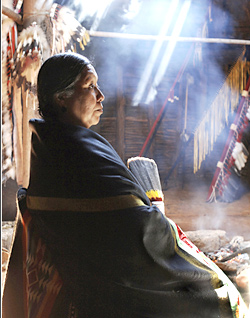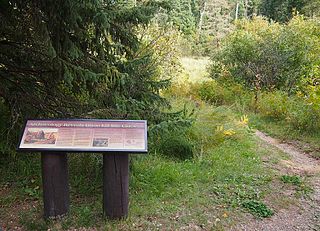William Duncan Strong (1899–1962) was an American archaeologist and anthropologist noted for his application of the direct historical approach to the study of indigenous peoples of North and South America.

The Plains Apache are a small Southern Athabaskan group who live on the Southern Plains of North America, in close association with the linguistically unrelated Kiowa Tribe. Today, they are centered in Southwestern Oklahoma and Northern Texas and are federally recognized as the Apache Tribe of Oklahoma.

The Plano cultures is a name given by archaeologists to a group of disparate hunter-gatherer communities that occupied the Great Plains area of North America during the Paleo-Indian or Archaic period.

Cowboy Wash is a group of nine archaeological sites used by Ancestral Puebloans in Montezuma County, southwestern Colorado, United States. Each site includes one to three pit houses, and was discovered in 1993 during an archaeological dig. The remains of twelve humans were found at one of the pit house sites, dating to the 12th century.
Waldo Rudolph Wedel was an American archaeologist and a central figure in the study of the prehistory of the Great Plains. He was born in Newton, Kansas to a family of Mennonites. In 1939 he married Mildred Mott, a fellow archaeologist and ethnohistorian. Wedel died in 1996 in Boulder, Colorado, about one year after Mildred's death.
Asa Thomas Hill, generally known as A. T. Hill, was an American businessman and archaeologist. His work on sites in and around Nebraska, with such collaborators as William Duncan Strong and Waldo Wedel, was instrumental in the development of Great Plains archaeology.
The Olsen–Chubbuck Bison kill site is located 16 miles (26 km) southeast of Kit Carson, Colorado. The Paleo-Indian site dates to an estimated 8000–6500 B.C. and provides evidence for bison hunting, using a game drive system, long before the use of the bow and arrow or horses. The site was named Olsen–Chubbuck after the amateur archaeologists who discovered the bone bed, Sigurd Olsen and Gerald Chubbuck. The Olsen–Chubbuck site was excavated between 1958 and 1960 by Joe Ben Wheat, an anthropologist employed through the University of Colorado Museum of Natural History. The site contains a bone-bed of almost 200 bison that were killed and processed by Paleo-Indian hunters.

Franktown Cave is located 25 miles south of Denver, Colorado on the north edge of the Palmer Divide. It is the largest rock shelter documented on the Palmer Divide, which contains artifacts from many prehistoric cultures. Prehistoric hunter-gatherers occupied Franktown Cave intermittently for 8000 years beginning about 6400 B.C. The site held remarkable lithic and ceramic artifacts, but it is better known for its perishable artifacts, including animal hides, wood, fiber and corn. Material goods were produced for their comfort, task-simplification and religious celebration. There is evidence of the site being a campsite or dwelling as recent as AD 1725.

The Jones-Miller Bison Kill Site, located in northeast Colorado, was a Paleo-Indian site where Bison antiquus were killed using a game drive system and butchered. Hell Gap complex bones and tools artifacts at the site are carbon dated from about ca. 8000-8050 BC.

The Basketmaker culture of the pre-Ancestral Puebloans began about 1500 BC and continued until about AD 750 with the beginning of the Pueblo I Era. The prehistoric American southwestern culture was named "Basketmaker" for the large number of baskets found at archaeological sites of 3,000 to 2,000 years ago.
The Dismal River culture refers to a set of cultural attributes first seen in the Dismal River area of Nebraska in the 1930s by archaeologists William Duncan Strong, Waldo Rudolph Wedel and A. T. Hill. Also known as Dismal River aspect and Dismal River complex, dated between 1650-1750 A.D., is different from other prehistoric Central Plains and Woodland traditions of the western Plains. The Dismal River people are believed to have spoken an Athabascan language and to have been part of the people later known to Europeans as Apaches.

The following outline is provided as an overview of and topical guide to the prehistoric people of Colorado, which covers the period of when Native Americans lived in Colorado prior to contact with the Domínguez–Escalante expedition in 1776. People's lifestyles included nomadic hunter-gathering, semi-permanent village dwelling, and residing in pueblos.
The Apishapa culture, or Apishapa Phase, a prehistoric culture from 1000 to 1400, was named based upon an archaeological site in the Lower Apishapa canyon in Colorado. The Apishapa River, a tributary of the Arkansas River, formed the Apishapa canyon. In 1976, there were 68 Apishapa sites on the Chaquaqua Plateau in southeastern Colorado.

Dent Site is a Clovis culture site located in Weld County, Colorado, near Milliken, Colorado. It provided evidence that humans and mammoths co-existed in the Americas.
Hell Gap complex is a Plano culture from 10,060 to 9,600 before present. It is named after the Hell Gap archaeological site, in Goshen County, Wyoming.
Sopris Phase is a Late Ceramic period hunter-gatherer culture of the Upper Purgatoire, also known as the Upper Purgatoire complex. It was first discovered in the southern Colorado, near the present town of Trinidad, Colorado. Sopris Phase appeared to be greatly influenced by Puebloan people, such as the Taos Pueblo and Pecos Pueblo, and through trade in the Upper Rio Grande area.

Cynthia Irwin-Williams was an archaeologist of the prehistoric American Southwest. She received a B.A. in Anthropology from Radcliffe College in 1957; the next year she received a M.A. in the same field. In 1963 she completed her educational career in Anthropology with a PhD. from Harvard University. Beginning her career in the 1950s, Irwin-Williams was considered a groundbreaker for women in archaeology, like her friend and supporter Hannah Marie Wormington.
Prehistoric technology is technology that predates recorded history. History is the study of the past using written records. Anything prior to the first written accounts of history is prehistoric, including earlier technologies. About 2.5 million years before writing was developed, technology began with the earliest hominids who used stone tools, which they may have used to start fires, hunt, and bury their dead.

The game drive system is a hunting strategy in which game are herded into confined or dangerous places where they can be more easily killed. It can also be used for animal capture as well as for hunting, such as for capturing mustangs. The use of the strategy dates back into prehistory. Once a site is identified or manipulated to be used as a game drive site, it may be repeatedly used over many years.











